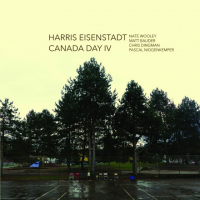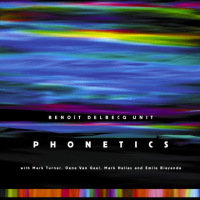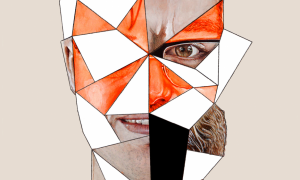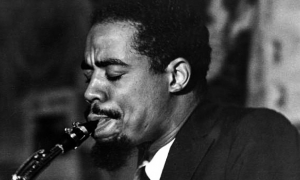Home » Jazz Articles » Hi-Res Jazz » Songlines: An Independent Voice for New Music
Songlines: An Independent Voice for New Music

Plot a zig-zag route from Vancouver, Toronto, Montreal, to San Francisco and Reno, from New York to Amsterdam, Paris and Berlin, with a stopover in Tehran, and you'll appreciate Songlines' geographic reach. The label's musical territory is not defined by language, history or culture; the goal of Songlines is to transcend boundaries.
"The term 'songlines' refers to Australian aboriginal performances of song and dance in which tales of the ancestral creator beings are enacted in the places where those events unfold in the now-and-always Dreamtime. This idea of a deep-roots musical journey seemed to offer a kind of metaphor for music in our globalizing world that forges imaginative new paths through different cultures and traditions without sacrificing the depth of those traditions." Tony Reif, excerpted from the Songlines website.
The imperative not to sacrifice the depth of cultural traditions is one of the guiding principles of Songlines. Among the label's earlier cross-cultural releases was an album of Persian music in traditional and modern settings (Amir Koushkani: Quest) and a trio of Amir Koushkani, clarinetist-composer François Houle and Puerto Rican-born percussionist-composer Sal Ferreras (Safa: Alight). Canadian guitarist Gordon Grdina, inspired by his studies of the oud, and of Egyptian and Iraqi music, recorded Gordon Grdina/Gary Peacock/Paul Motian: Think Like the Waves and Gordon Grdina's Haram: Her Eyes Illuminate. Label founder Tony Reif has a longstanding connection to world music through his own artistic participation in the ensemble Gamelan Madu Sari.
Songlines albums from the mid-1990s include breakthrough recordings by musicians in the New York "downtown" jazz scene who went on to become highly influential in shaping the direction of new music, among them Dave Douglas: Tiny Bell Trio, Ben Monder: Flux, Ellery Eskelin: Jazz Trash, and Chris Speed: Yeah No.
The Songlines model is artist-centered. Tony Reif functions as the executive producer, and most recordings are musician-produced. Some projects receive financial support from the Canada Council, and some of the French recordings through government-related arts subsidies. But as Reif explains:
"More often, projects are funded (these days) though a combination of money out of the artist's own pocket, along with a usually smaller amount from Songlines. This is very different from what it was when I started. Of course, the whole financial basis of the recording industry at every level has been severely undercut by streaming."
Despite the daunting financial challenges of operating a jazz label in an era of diminishing sales revenues, Songlines remains committed to releasing its productions in the highest quality audio. Nearly all Songlines titles recorded from 2001 to 2009 were pressed as hybrid multi-channel SACDs. In 2009, the label switched platforms to hi-resolution downloads and CDs, and reissued its SACD catalog as stereo hi-resolution files.
Optimum sound quality is a hallmark of Songlines' productions. Though recordings are made in studios in New York, Vancouver, Paris and elsewhere, many Songlines releases receive final mastering by Graemme Brown at Zen Mastering in Gabriola Island, BC.
"I try to make sure that the studios and engineers I'm working with understand the sonic aesthetic I'm after—which is not an unusual one for jazz—unlike Chesky's or M-A's minimalist approach, which I think would be more expected in classical chamber music. In that sense, I don't think of Songlines as an audiophile label, or anyway not a purist one. I believe in close mic'ing, isolation (where needed for technical reasons) and reverb, a little compression or limiting here and there, maybe some overdubbing, whatever enhances the music and realizes the composer/performers' intentions. We're fostering or (re)creating an illusion, the illusion of being in the presence of the musicians as they are performing, in an ideal (upfront) seat. For that you need good equipment and flexible studios and engineers who know how to use the means at their disposal, know what real, acoustic-electric music sounds like."
The development of long-term working relationships with composer-musicians is one of Songlines' most lasting accomplishments. Songlines artists record for other record labels, but their artistic progress can be clearly charted over the years of their Songlines productions. Benoît Delbecq has eight Songlines releases under his own leadership, and appears on numerous other sessions; with the group Kartet; pianist Andy Milne and clarinetist Francois Houle. The evolution of composer-drummer Harris Eisenstadt's Canada Day and Golden State ensembles has been documented on five Songlines releases since 2011. Guitarist Brad Shepik, widely active in the New York and European jazz scene, has recorded numerous times for Songlines.
In 2016, the label released a hi-res download album and CD of Brad Shepik and Ron Samworth's session Quartet 1991, digitally mixed and mastered from analogue tapes recorded in the title year. It was an early effort by producer Tony Reif to capture the excitement of the Seattle/Vancouver jazz scene at the beginning of the decade. The tapes were shelved for 25 years, and their current incarnation as hi-res downloads makes a useful case study of how technology can serve to archive and distribute older recordings in the computer audio environment.
Brad Shepik/Ron Samworth: Quartet 1991
 In a recording career spanning 25 years, Brad Shepik has led 10 sessions under his own name and appeared on 70 more as a sideman. His stylistic flexibility and wide-ranging interests have kept him in demand, in projects ranging from Dave Douglas' Tiny Bell Trio to Paul Motian's Electric Bebop Band, to Simon Shaheen's Quantara.
In a recording career spanning 25 years, Brad Shepik has led 10 sessions under his own name and appeared on 70 more as a sideman. His stylistic flexibility and wide-ranging interests have kept him in demand, in projects ranging from Dave Douglas' Tiny Bell Trio to Paul Motian's Electric Bebop Band, to Simon Shaheen's Quantara. Prior to leaving his native Seattle for greater opportunities in New York, Brad Shepik wrote a set of original compositions for two guitars, acoustic bass and drums. Ron Samworth, a long-time contributor to Vancouver's jazz scene, brought in several of his own compositions. Tony Reif and engineer Jay Follette recorded the quartet of Shepik, Samworth, bassist Phil Sparks and drummer Michael Sarin for two days. On evaluation, the creative team decided that the performances didn't do justice to the compositions. The sessions remained unreleased until recently, when Tony Reif had the 2" multitrack analogue tapes transferred to 24/192 digital, which allowed him and engineer Erik Nielsen to review, remix and edit the performances to bring out the strengths and minimize the (perceived) flaws in the original sessions.
Artists can be the harshest judges of their own work. The performances on Quartet 1991 stand on their own merits, without excuse for insufficient rehearsal time. The record sounds lively and compelling 25 years after it was recorded and it's notable that the set doesn't sound mired in the downtown musical vibe of the early 1990s. Shepik's tone palette varies from clean to distorted, his melodic lines from legato fast-tempo triplets to choppy staccato phrases. Guitarist-composer Ron Samworth has expressed misgivings about his own performance on the Quartet 1991 sessions. His feelings notwithstanding, the first-time listener to this recording is likely to find more in Samworth's playing to admire than to critique. He plays very tightly in rhythmic and thematic synch with Shepik, and his solos are refreshingly cliché-free.
There's a mood of exploration, rather than destination, in many of the pieces. The lead-off, "Confluenza," opens with an "oriental" minor-key phrase played in near-unison by the two guitarists in a style reminiscent of King Crimson's Discipline period. Controlled dynamics and spare drumming opens space for Samworth's cerebral soloing. A quiet interlude precedes the climax and coda.
"Terrestrials" follows a more conventional head and solos form, but leans closer to prog-rock in its overall impact than to jazz fusion or earlier modern jazz styles. Shepik was born in 1966 and was as likely to be influenced by the revival of progressive rock in the 1980s as the wave of jazz-rock fusion from the early 1970s. Noise-making played over frameworks of disciplined rhythms; quiet passages that burst out unexpectedly in torrents of musical aggression.
Highlights of the set are the contemplative "Nightbirds" and the closing "Song of Then," the longest track on the album. "Nightbirds" is a tightly-structured multi-part piece that mixes composed lines and short improvisational passages. It's a satisfying, melodically memorable work. "Song of Then" with its expansive 9-minute length, includes a well-conceived bass solo from Phil Sparks and subtle rhythmic support from drummer Michael Sarin, and draws the set quietly to its conclusion.
Transferring an original analogue recording directly (and conscientiously) to hi-res digital preserves the analogue character of the sound. While many original digital recordings from the late 1980s and early 90s sound artificial, hard and flat, the 24/192 transfer of the Quartet 1991 multitrack studio tapes, and the careful efforts to mix, edit and master them, yields a warm sonic playback experience, more like a good late-era LP than an antiseptic early CD.
In the 25 years since he recorded Quartet 1991 Brad Shepik has continued to grow and develop as a player and composer. This early example of his composing was well worth preserving and distributing. Songlines' successful history with Shepik attests to the confidence Tony Reif expressed in 1991when he financed the sessions. Shepik's ambitious Human Activity Suite, originally released by Songlines on SACD in 2009 and currently available on CD and hi-res download, won high praise from jazz critics.
Track Listing: Confluenza; Terrestrials; Bent House; Circa; Nightbirds; PLAW; Ramblin'; Way In; Song of Then
Personnel: Brad Shepik, electric guitar (left channel); Ron Samworth, electric guitar (right channel); Phil Sparks, bass; Michael Sarin, drums
Format: Recorded in multi-track analogue, mixed and mastered 24/192 digital
Harris Eisenstadt: Canada Day IV
 Composing new music for players who live in different parts of the world places unique demands and constraints on the composer, and on the record label. In the liner notes to Canada Day IV, Harris Eisenstadt addresses the circumstances that delayed the recording:
Composing new music for players who live in different parts of the world places unique demands and constraints on the composer, and on the record label. In the liner notes to Canada Day IV, Harris Eisenstadt addresses the circumstances that delayed the recording: "I brought the pieces into rehearsals, then we played a series of concerts over the course of a year. We started with a four-night run in May 2014 at Douglass Street Music. I was tempted to record after that first run, but decided instead to let the material gestate. Due to scheduling challenges (everyone in the band is, predictably, super-busy), we did not re-convene until our European tour in November 2014... and we returned ready to record, but I had booked some New York concerts long in advance and decided to keep them, to let the material percolate further. Finally, in January 2015, we... made the record in a seamless day-long session."
The passage of so much time from composition to recording, during which Eisenstadt and his colleagues were only able to convene for a short tour and a brief residency, raises concerns about the forces adversely impacting the development of jazz. The scheduling demands on working musicians, the high costs of touring and low compensation for performing, and the geographic distance that separates players are factors in slowing the rate of development of new music, and especially, the speed with which audiences are apprised of those developments.
In this instance, the payoff for the project's long gestation is a fully realized album distinguished by consistently excellent writing and performances. The set is marked by Eisenstadt's interest in the 1970s AACM and mid-1960s post-bop streams of American jazz. "After Several Snowstorms" opens the album in media res with a bass and vibes interlude, then progresses, in a kind of inverse to conventional form, to a tenor sax solo, and then to a statement of the head by the full ensemble. A solo by the gifted and adventurous trumpeter Nate Wooley evokes a roomful of antecedents, from Miles Davis circa Filles de Kilimanjaro to Don Cherry, to Bill Dixon. A second statement by the ensemble fades into a bass and vibes interlude, a conclusory ensemble passage, and a dissonant accented phrase from the two horns. It's a low-key opening that calls the listener, in parallel to the music, to slow down, take a breath and focus on the complex and intriguing work that follows.
"Sometimes It's Hard to Get Dressed in the Morning" continues in the vein established in the opening track: a sequence of short passages in shifting time signatures. Call-and-response horn soloing over hypnotic rhythms from the vibes and drums (Eisenstadt studied with Gambian musicians) leads into a trumpet solo. Wooley runs through permutations on short melodic "cells," graduates to longer phrases reminiscent of Miles' late acoustic period, and finally bursts out into free jazz idiom. Tenor saxophonist Matt Bauder, picking up on Wooley's cue, begins his solo with extended technique overtone blowing, gradually shifts into a line of melodic phrases, then returns to overtones—all with reserve and economy.
The fourth track in the set, "Life's Hurtling Passage Onward," most clearly points to the stylistic innovations of the Blue Note Records house composers of the mid-1960s: Andrew Hill, Grachan Moncur III, Bobby Hutcherson and Joe Chambers. Chris Dingman's vibraphone sound is reminiscent of Hutcherson, though his melodic constructions are very much his own. Drummer Eisenstadt's patterns borrow from Chambers and Tony Williams. The melancholy ensemble passages wouldn't be out of place on Hutcherson's Dialogue or Moncur's Evolution. Bauder walks in the footsteps left by Joe Henderson and Sam Rivers. But at the midpoint of the piece, the almost reverent, nostalgic evocation of the Blue Note era transitions to the reality of the present: Nate Wooley's startling, free-blowing solo, first unaccompanied, then underscored by vibraphonist Chris Dingman, fades into ghostly silence over the sound of the vibraphone set to a fast vibrato.
It's a saddening—and salutary—reminder that as much as we might wish otherwise, the past cannot be relived, only reconsidered.
Track Listing: After Several Snowstorms; Sometimes It's Hard to Get Dressed in the Morning; Let's Say It Comes in Waves; Life's Hurtling Passage Onward; What Can Be Set to the Side; What's Equal to What; Meli Melo
Personnel: Nate Wooley, trumpet; Matt Bauder, tenor saxophone; Chris Dingman, vibraphone; Pascal Niggenkemper, bass; Harris Eisenstadt, drums, compositions
Format: 24/192 download with PDF booklet
Benoît Delbecq: Phonetics
 Phonetics was a jazz/new music project assembled in 2003 for concerts and recording by pianist-composer Benoit Delbecq. The music eludes straightforward genre classification; it is neither contemporary classical music nor European jazz of the ECM variety, though it bears some similarity to projects led by clarinetist Louis Sclavis. In his formative years, Delbecq drew inspiration from the American jazz pianist Paul Bley and South African pianist-composer Abdullah Ibrahim; Hungarian composer-theorist Gyorgy Ligeti; the polyrhythmic music of Central Africa. All of these diverse musical streams reveal traces in this set of performances, but the overall work is greater than the sum of its influences.
Phonetics was a jazz/new music project assembled in 2003 for concerts and recording by pianist-composer Benoit Delbecq. The music eludes straightforward genre classification; it is neither contemporary classical music nor European jazz of the ECM variety, though it bears some similarity to projects led by clarinetist Louis Sclavis. In his formative years, Delbecq drew inspiration from the American jazz pianist Paul Bley and South African pianist-composer Abdullah Ibrahim; Hungarian composer-theorist Gyorgy Ligeti; the polyrhythmic music of Central Africa. All of these diverse musical streams reveal traces in this set of performances, but the overall work is greater than the sum of its influences. Phonetics was written with a group of musicians in mind, most of whom had not previously played with Delbecq: Mark Turner (tenor saxophone), Oene Van Geel (viola), Mark Helias (bass) and Emile Biayenda (percussion). Delbecq described his plan for assembling these particular musicians:
"I wanted to provoke an encounter between musicians I knew from different scenes, Europe meets North America meets Africa... When I started writing I had a sound in mind and in a way the work was to reveal it... The summer before the project Emile and I had gotten together several times for several days, trying to develop a very open but very rhythmic way of playing, and some of the tunes were inspired by those sessions. The mixed sounds of tenor and viola were in a sense the key to the group... I didn't want the whole thing to sound too arranged."
That provides a helpful guideline for listening. The pieces on Phonetics indeed sound arranged, but not to a point of inhibiting the creative impulse and improvisational skill of the players. The pianist and drummer spent time working together on the structural concept and foundational sound of the project. There was dialogue and room for discovery.
"Le Même Jour" opens with a polyrhythmic backdrop on hand percussion and drum kit, over which the piano and saxophone play a long-line melody in unison. Melodic lines played in unison by groupings of two is a technique that recurs throughout the disc. An historical antecedent is Ornette Coleman and Don Cherry's unison 'heads' in the 1959-61 Coleman group recordings and performances. The unison melodies serve a similar function here: to establish a set of intervals and rhythmic figures which the players can use in lieu of a fixed chord progression as material for their improvisations. Solo space is 'free' but guided by the structures established in the opening melody. Bassist Mark Helias listens closely and follows the soloists, insuring that the improvised segments are not untethered or chaotic. Delbecq's piano solo develops variations on the opening theme while Helias and Biayenda punctuate the keyboard phrases with surging accents.
"Multikulta," a highlight of the set, begins with an unaccompanied solo on tenor saxophone. Delbecq invited saxophonist Mark Turner to participate in the recording (and the concert appearance for which these compositions were commissioned on the basis of Turner's recordings and recommendations from fellow musicians. It was a fortuitous musical encounter. Turner has emerged in the past decade as a respected composer-leader and a capable, inventive soloist. His preference for working inside chamber-jazz structures makes him a highly compatible partner for Delbecq. There is a certain cautious reserve and self-containment in Turner's playing that I've seen him surpass in live performance. Here, propelled by the precise and powerful drumming of Emile Biayenda, supported by the framework of Delbecq's intricate structures, Turner weaves confident melodic lines. His staccato, percussive opening phrases echo Sonny Rollins' avant-garde collaborations with Don Cherry from the mid-1960s.
Each of the pieces provides space for the soloists to add to the blend of African, European and North American influences. "The Elbow Room, Vancouver," which moves through a series of short segments like a suite in miniature, features a driving bass and drum duet with furious variations on the opening melody by Mark Helias. The meditative "4 Mal W" introduces Delbecq's second keyboard, a sampler which enlarges his tonal palette beyond the grand piano to the exotic sounds of gamelan instruments. "Yompa" shares the Congolese musical traditions which Emile Biayenda, born in Brazzaville, brought with him to France. As the drums and bass call a fast 6/4, the viola, saxophone and piano respond in a slow 4/4; the effect is trancelike and attention-holding.
The lengthy closing piece "Au Louvre" recapitulates the elements that have recurred throughout the set, long unison lines, intricate rhythmic patterns, multi-part arrangements. Belgian violist Oene Van Geel's bravura solo, which draws on classical technique (scales, arpeggios, double-stops), Arabic melodic vocabulary and bent-note microtonality, is both an individualistic statement and a contribution towards the overall, integrative mood of the project.
The recording was done at La Muse en Circuit, Alfortville-Paris (which remains Delbecq's preferred studio) in November 2003. Original resolution was 24/48. It was mixed in the analogue domain to 2.0 and 5.0 DSD programs. Delbecq describes the character of sound he was seeking:
..." For the five-channel version we chose the option of putting the band in an imaginary great-sounding room. No instruments are panned to the rear channels."
Delbecq's recent work for Songlines includes Funhouse, a double piano trio album co-led by pianist Fred Hersh, and a new recording with the French chamber jazz ensemble Kartet, Grand Laps.
Track Listing: Le même jour; Multikulta; Zao Wou-ki; Pointe de la courte dune; The Elbow Room, Vancouver; 4MalW; Yompa; Au Louvre
Personnel: Benoît Delbecq, piano, sampler, compositions; Mark Turner, tenor sax; Oene van Geel, viola; Mark Helias, bass; Emile Biayenda, drums
A VOYAGE OF DISCOVERY
Many jazz lovers dream of owning their own independent record labels, but few have had the means and opportunity; and of that small circle of label owners, only a handful have kept a business operating—and thriving, artistically—for a span of 25 years. Prompted to reflect on his vision for the Songlines label, Tony Reif shared these observations:
"When I look back over 25 years—which doesn't seem that long a time in the context of jazz's history—it's been like the proverbial voyage of discovery. I'd been a jazz fan since the 60s, and an audiophile since the 70s. The label has developed an identity, and there are some genres that just seem too far away from jazz or world music to fall within the label's purview (though at this point I really wouldn't rule anything out, since musical boundaries keep dissolving). You start, with some intentions but no hands-on experience of producing, on an open-ended project, and little by little, record by record, you learn specific things, meet and work with people you admire, help shape the sonics and sometimes the substance of music you feel is worthy of attention.
The label is an imaginative home for a considerable part of my musical experience, it's where I get to advocate in a practical way for things I love. But to go back to the original metaphor, it's hard to see a through—line, or where exactly the paths are heading, because so much of it has been serendipitous. Which is part of the charm of it."
Special thanks to Tony Reif for quotes excerpted from communications with this author and from the Songlines website.
Note: The review of Phonetics originally appeared in a different form on HRAudio.net, and is reprinted with permission of the site owner.
< Previous
Westering Home
Comments
Tags
Brad Shepik
Hi-Res Jazz
Mark Werlin
Canada
Vancouver
Songlines Recordings
Benoit Delbecq
Harris Eisenstadt
Gordon Grdina
Wayne Horvitz
Francois Houle
Andy Milne
nate wooley
Miles Davis
Don Cherry
Bill Dixon
Matt Bauder
Andrew Hill
Grachan Moncur III
Bobby Hutcherson
Joe Chambers
Chris Dingman
Tony Williams
Louis Sclavis
Paul Bley
abdullah ibrahim
Mark Turner
Oene van Geel
Mark Helias
Emile Biayenda
Concerts
Apr
26
Fri
Stream
Apr
26
Fri
Stream
For the Love of Jazz
 All About Jazz has been a pillar of jazz since 1995, championing it as an art form and, more importantly, supporting the musicians who create it. Our enduring commitment has made "AAJ" one of the most culturally important websites of its kind, read by hundreds of thousands of fans, musicians and industry figures every month.
All About Jazz has been a pillar of jazz since 1995, championing it as an art form and, more importantly, supporting the musicians who create it. Our enduring commitment has made "AAJ" one of the most culturally important websites of its kind, read by hundreds of thousands of fans, musicians and industry figures every month.



























